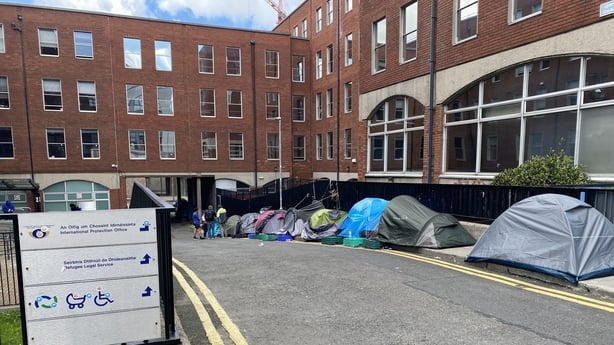A deal agreed in Luxembourg last night has been billed as a "hugely significant step" and a way to "modernise the EU's rulebook for asylum and migration".
Yet some of what was agreed by the EU's ministers might sound familiar.
For example, the new solidarity mechanism sounds a lot like the Voluntary Solidarity Mechanism (VSM) that we coincidently heard a lot about yesterday after cabinet agreed that Ireland would pay €1.5 million to it, rather than accepting an agreed number of asylum seekers under the relocation scheme.
This deal was almost a decade in the making, and it does bring in significant changes, but it also builds on the current international protection system.
So how did we get here?
Ever since 2015, when a peak number of 1.3 million people sought asylum in Europe as war in Syria raged, processing and hosting people seeking refuge has become in increasingly divisive issue within the EU.
The Dublin III Regulation left the countries that were the first point of irregular entry primarily responsible, with some exceptions.
Countries on the EU's southern edge, including Italy and Greece, were overwhelmed by the numbers arriving on their shores and demanded more help to cope from member states.
The European Commission accepted that the "volume and concentration of arrivals" exposed the weaknesses of the system - and in 2016 work began on replacing it with one that looked to share the responsibilities.
Read more: EU reaches long-stalled deal on refugee hosting
EU refugee reform deal 'unacceptable' - Hungary
It took until September 2020 before the European Commission proposed a "New Pact on Migration and Asylum" to introduce a permanent mechanism to relocate asylum-seekers across the bloc.
But this stalled when Hungary, Poland and the Czech Republic immediately opposed.
In the background, the urgency had ebbed away somewhat as the numbers seeking refuge in Europe normalised after 2017, but post-Covid that changed too.

The EU recorded almost one million asylum requests in 2022, the highest since 2016, and while historically Ireland's level of asylum applications were low compared with other European countries, this changed last year, with a record 13,651 people seeking international protection in 2022.
The VSM was hailed as a breakthrough of sorts and a potential stepping-stone for an EU wide asylum seeker relocation scheme.
Introduced in June 2022 the non-binding agreement was backed by 23 countries, including 19 member states including Ireland.
It introduced a mechanism whereby countries could accept asylum seekers from another member state but also allowed for members to make financial contributions instead.
However, it also highlights some of the problems.
The VSM set a goal of relocating 8,000 asylum seekers per year, but by February this year only 435 migrants were moved under the scheme.
Ireland's own decision to opt to pay rather than relocate an agreed number of asylum seekers here amid the ongoing accommodation crisis is another example of these challenges.
New solidarity mechanism
Nevertheless, last night, the EU's justice and interior ministers voted in support of introducing a mandatory scheme based on similar principals.
If adopted, all member states would have to take part in the new EU solidarity mechanism but the European Council insists that how they do that would remain up to them.
The two main options are: accept an allocation of international protection applicants to be relocated to their country, or make financial contributions of €20,000 per person they do not take.
However the proposal also suggests other "solidarity measures" may be available as deploying personnel to those states dealing with large numbers of asylum seekers or focusing on capacity building in those countries.
Minister of State at the Department of Justice, James Browne attended the meeting in Luxembourg where agreement was reached last night.
Speaking to RTÉ before flying home Mr Browne confirmed that "Ireland hasn't adopted it yet", saying there were a number of legal issues that needed to be considered.
"When there is a final adoption which will be by the European Parliament (and the European Commission) then we will consider our situation about opting into this new set of regulations," he said.
However he stress that Ireland "fully supported the process, we supported the decision yesterday" adding that "we acted in good faith and fully participated in the negotiation process at every stage."
In a statement issued this evening, Minister for Justice Helen McEntee also welcomed the agreement reached and said: "We will continue to contribute to the negotiations over the coming months and will examine the issues carefully so that Government can make an informed decision on participation in the future."
Asylum Procedure Regulation
The second agreement reached was on asylum procedures on the EU's external borders.
This text obliges those member states to put in place fast-track procedures for arrivals from countries deemed as safe in order to facilitate their return.
However, it also allows countries to stop processing people at the border if they reach a certain limit.
The new asylum and migration management regulation is intended to replace the current Dublin regulation, however there is still a way to go yet.
The deal needed to secure approval from Ministers from a majority of countries representing at least 65% of the bloc's population.
Poland and Hungary voted against the proposals, while Bulgaria, Malta, Lithuania and Slovakia abstained.
Ireland has welcomed it, with Minister of State James Browne, who was in Luxembourg, saying it aims to "create a fairer, more efficient, and more sustainable migration and asylum system across the EU."
Now the Council vote has been won, negotiations begin with the European Parliament and the European Commission.
The plan is to see the whole thing signed off on before the European elections in June 2024.






